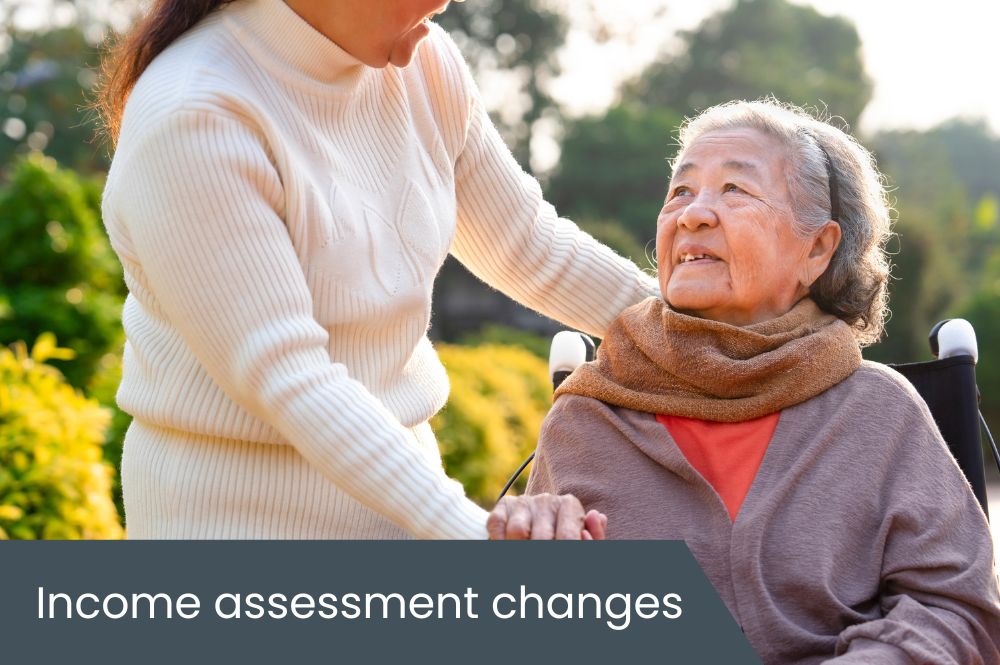How changes to the income assessment affects older Australians

The Australian Government has increased the rates used to assess income from financial assets for the Age Pension and other income support payments. For families supporting an older loved one, this change may feel like yet another financial curveball, especially if it results in a reduced pension and higher costs for home care (Support at Home) or aged care.
This increase ends a five-year freeze introduced during the pandemic, reflecting the steady rise in interest rates and investment returns since 2020. While it may seem like a technical adjustment, it can have real emotional and financial consequences for families already navigating the complexities of aged care.
The new deeming rates
- 0.75% (up from 0.25%) on financial assets up to:
- $64,200 for singles, or
- $106,200 for couples combined.
- 2.75% (up from 2.25%) on financial assets above those thresholds.
Deeming applies to all financial assets, including bank accounts, term deposits, shares, managed funds, and most account-based pensions (other than those account-based pensions with special income test treatment under old rules).
The government’s rationale is that the old rates no longer reflected reality. But for families, the reality is this: less pension can mean more out-of-pocket costs, and that can be stressful when you’re trying to ensure your loved one receives the care they deserve.
Who is affected?
Means tested pensions such as the age pension are subject to an assets and income test and whichever pays the least determines the rate of pension entitlement.
If the assessed income exceeds $218 a fortnight (single) or $380 (couple), then the pension entitlement under the income test will be reduced.
As a guide:
- A single pensioner with over $252,800 in financial assets that are deemed will now have their pension entitlement determined by the income test.
- Couples with $436,510 subject to deeming, will now have assessed income of $380 a fortnight.
For example, a single pensioner with $300,000 in financial assets has the first $64,200 deemed to earn 0.75% p.a. and 2.75% p.a. on the balance of $235,800, making a total of $6,966 a year ($267.92 a fortnight) of deemed income. For every $1 over the $218 per fortnight threshold, the pension reduces by $0.50 per fortnight. So, the pension reduces from the maximum of $1,178.70 per fortnight to $1,153.74 a fortnight.
Why deeming matters for aged care
Deeming rates don’t just affect Age Pension payments; they also determine aged care means-tested fees. Both the Age Pension income test and the aged care means test assume that financial assets earn income at the deeming rates, regardless of the actual interest or earnings.
For residents in aged care, higher deemed income can lead to:
- Reduced Age Pension entitlements, and
- Higher means-tested care fees under the aged care assessment rules.
This is particularly relevant for those who sold their home, as their home proceeds often shift into financial assets subject to deeming. Even if money is in a bank account paying low interest, it will be deemed to earn up to 2.75% p.a.
Because deeming feeds into aged care fees that are subject to means testing, higher deemed income can mean higher daily fees.
It’s a subtle but important reminder that aged care planning doesn’t stop upon entering care. Changes like this can shift affordability over time.
What families should watch
- Reassess your Age Pension entitlement: Pensioners may see changes to their Centrelink payment after 20 September.
- Review aged care fee notices: Those already in care could see their means-tested contributions recalculated over the coming months.
- Consider investments: Review how funds are invested (e.g. term deposits, shares and income streams). Not all investments are subject to deeming, and it can be timely to review options.
- Home Care or Aged Care fees: With new funding rules commencing 1 November 2025, understanding how deemed income interacts with both fees and pension will be increasingly important.
The value of professional advice
The deeming rate increase is modest, but it ends a long period of artificially low assumptions about investment income. For many older Australians, particularly those navigating aged care, the change underscores how small policy shifts can ripple through income support and care costs.
Families entering or already in aged care should stay alert to how these rates affect both cash flow and contribution assessments, especially during this broader transition to the new aged care funding model.
Even small changes in deemed income can make a meaningful difference to daily affordability, and understanding those impacts early can help families plan with confidence.
If you have any questions or need guidance on any aspect of the aged care finance journey, please do not hesitate to get in touch. With a specialist division of financial advisers who are accredited in aged care advice, we have a team that can talk you through the various options and explain the various financial considerations. Our team can also connect you with trusted organisations who can help guide you through the care choices that best align to your unique care situation. Learn more about our accredited aged care financial advisers.
Download our guide to aged care
Our exclusive booklet illustrates examples where specialist financial advice may assist in significantly improving financial outcomes. Complete the form below and your copy will be emailed to you.
More insights
Margaret’s journey through life’s sudden changes
Margaret and her husband had always imagined a relaxed retirement. They loved spending weekends gardening and planning family get-togethers. In late 2023, they sold their home with plans to downsize and move closer to family…
When do we start the aged care conversation?
Kerri is a specialist lifestyle and care financial adviser based in our Brisbane office. She is committed to helping families navigate the transition into aged care or retirement living with clear, tailored advice.When should the aged care conversation commence? At...
How upcoming aged care fee changes may affect you
From 1 November 2025, the new aged care reforms come into effect. While many new residents will face higher costs under the new rules, what does this mean for the 220,000+ people already living in residential aged care? Here’s what you and your loved ones need to...



